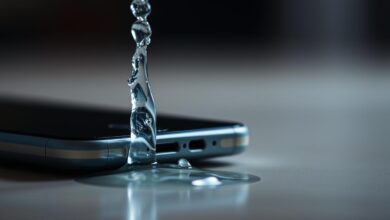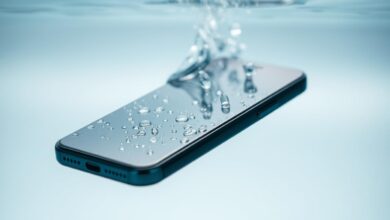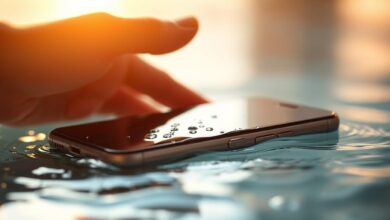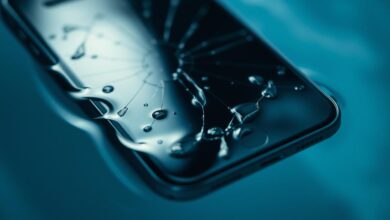Sounds to Get Water Out of Phone
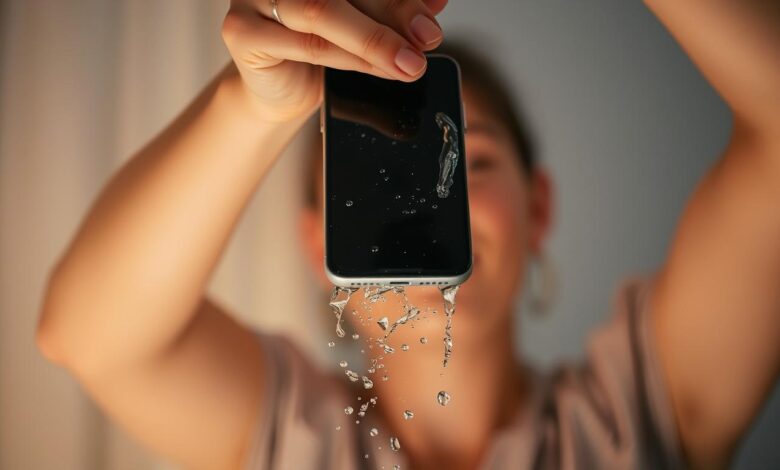
Dropping your phone in water can be really stressful. Water damage can cost a lot to fix or even make your phone useless. It’s very important to act fast to minimize the damage.
Water in your phone can cause corrosion and harm the inside parts. It can also make your phone stop working right. Some people use sounds to try and get water out of their phones. This method is getting more attention for its possible benefits.
This idea uses sound waves to push water out of your phone’s speakers and openings. It might sound strange, but some people say it works.
Key Takeaways
- Water damage can be costly to repair.
- Acting quickly is crucial to minimize damage.
- Using sounds to remove water is an unconventional method.
- This technique involves using sound waves to expel water.
- Some users have reported success with this method.
Understanding the Problem of Water Damage
It’s important to know how water affects your smartphone. Water and electronics don’t get along, and even a little exposure can cause big problems.
Water can short circuit your phone, corrode parts, and harm the circuitry inside. The damage depends on how much water, for how long, and your phone’s design.
How Water Affects Your Phone
Water can get into your phone through openings like the charging port or speakers. Once inside, it can harm important parts like the logic board and battery.
Corrosion from water can cause permanent damage. It’s crucial to act fast. Even if your phone seems fine after water exposure, there might be hidden damage.
Common Symptoms of Water Damage
Spotting water damage early is key. Look out for these signs:
- Corrosion or rust around the SIM card slot or charging port
- Water indicators turning red or pink, indicating exposure to water
- Screen malfunction or unresponsive touch
- Speakers not working properly or producing distorted sound
- Phone not turning on or shutting down unexpectedly
Knowing these symptoms helps you take the right steps to fix or protect your phone.
| Symptom | Description | Possible Cause |
|---|---|---|
| Corrosion | Rust or greenish deposits around ports | Water exposure causing metal oxidation |
| Screen Issues | Unresponsive or distorted display | Water seepage into the screen or logic board damage |
| Audio Problems | Distorted sound or non-functional speakers | Water damage to speaker components or circuitry |
The Science Behind Water Removal Sounds
Understanding the science behind water removal sounds is key to seeing how it works. This method uses sound frequencies to help dry out phones damaged by water.
What Are Drying Sounds?
Drying sounds are special sound frequencies made to work with water in phones. They are sounds we can hear and are made to shake water out of the phone’s parts.
The science behind drying sounds comes from how sound waves work with liquids. When sound waves hit water, they make it vibrate and push it out of the phone.
How Sounds Can Help
Sounds help in removing water from phones in a few ways. First, they create pressure changes that push water out. Second, the vibrations from the sound help move water droplets off phone parts.
Key Benefits of Using Sound for Water Removal:
- Non-invasive technique
- Potential to reduce water damage
- Can be used in conjunction with other drying methods
Studies show that some frequencies work better than others. High-frequency sounds, for example, are good at making strong vibrations to push out water.
| Frequency Range | Effectiveness | Application |
|---|---|---|
| High Frequency (>10 kHz) | High | Effective for dislodging water from small crevices |
| Low Frequency (<1 kHz) | Moderate | Useful for larger water droplets |
| White Noise | Variable | Can be used in combination with other frequencies |
“The use of sound waves for water removal is a new way to deal with water damage in phones. By knowing the physics, we can make this method better.”
In summary, the science of water removal sounds is based on how sound waves interact with water. By using this knowledge, people can use sound to dry out phones and avoid water damage.
Types of Sounds to Try
To get water out of your phone, knowing the right sounds is key. Sounds can help by making vibrations that push water out of your phone’s parts.
High-Frequency Tones
High-frequency tones are great for getting water out of small spots like speakers. They make quick vibrations to push water out. Use tones between 15 kHz and 20 kHz for the best results. Remember to keep the volume low to avoid harming your phone’s speakers.
Low-Frequency Vibrations
Low-frequency vibrations are better for bigger areas, like the charging port. They work in the 50 Hz to 200 Hz range. These vibrations can get deep into your phone to remove water from inside.
White Noise and Its Effect
White noise, with its mix of all frequencies, can also help. It makes a steady vibration across many frequencies. This can be good when you’re not sure what frequency to use.
In summary, sounds like high-frequency tones, low-frequency vibrations, and white noise can help. Knowing how each sound works can help you choose the best one for your phone.
How to Use Sound Apps Effectively
Sound apps can help remove water from phones, but they work best when used right. It’s key to know how they work and how to set them up for the best results.
Choosing the Right App
Finding the right sound app can be tough. When looking to remove water from your phone, consider a few things:
- Look for apps with a range of frequencies. Different frequencies might work better for different types of water.
- Read reviews from others who’ve used the app for this purpose.
- Choose an app that lets you adjust settings like volume and frequency.
A study found that the success of sound-based water removal depends on the sound’s frequency and amplitude.
“The right frequency can significantly enhance the removal of water from the phone’s internal components.”
Maximizing Volume and Clarity
To get the most out of a sound app, make sure the volume is just right. Higher volumes are often more effective, but don’t hurt your phone’s speakers. Finding the right balance is important.
Clarity matters too. Make sure the sound is clear and not muffled. Apple Support recommends using good external speakers for better sound and results.
By picking the right app and adjusting volume and clarity, you can boost your chances of removing water from your phone. Be careful and patient, as it might take some time.
DIY Sound Techniques for Water Removal
To save your water-damaged phone, try making custom sound waves. This method uses special sound waves to push water out of your phone’s parts.
Creating Custom Sound Frequencies
Making custom sound waves is easy with a few tools and some knowledge. You can use a tone generator app or software to make the right sounds. Frequencies between 20 Hz and 20 kHz work well because they’re in the range we can hear.
To make custom sound waves, do this:
- Download a tone generator app or software.
- Set the frequency to between 20 Hz and 20 kHz.
- Play the sound at maximum volume near your phone.
Using Your Home Speakers
If you don’t have a smartphone app or prefer something simpler, use your home speakers. Make sure your speakers can play clear sound without distortion to get the best results.
| Method | Tools Required | Effectiveness |
|---|---|---|
| Custom Sound Frequencies | Tone generator app/software, smartphone | High |
| Home Speakers | Home speakers, tone generator app/software | Medium to High |
These DIY sound methods might fix your water-damaged phone without needing a pro. Just be patient and keep trying, as finding the right sound takes time and effort.
Other Home Remedies for Water Removal
There are many home remedies to dry out your phone, aside from sound-based methods. These methods have been around for a while and can work in some cases.
Rice and Silica Gel Alternatives
Using rice or silica gel to fix water damage repair is common. You put your phone in a container with rice or silica gel. The desiccant pulls out the water.
But, rice can be messy and not as good as silica gel. Silica gel is stronger because it’s used to keep things dry in packaging. It’s great for drying out your phone too.
| Desiccant | Effectiveness | Messiness |
|---|---|---|
| Rice | Moderate | High |
| Silica Gel | High | Low |
Vacuum Sealing Techniques
Vacuum sealing is another way to fix water damage repair. Put your phone in a vacuum-sealed bag or container. The vacuum’s suction can pull out the moisture.
Be careful with this method. Too much suction can harm your phone’s inside parts. Use a gentle vacuum setting and watch it closely.
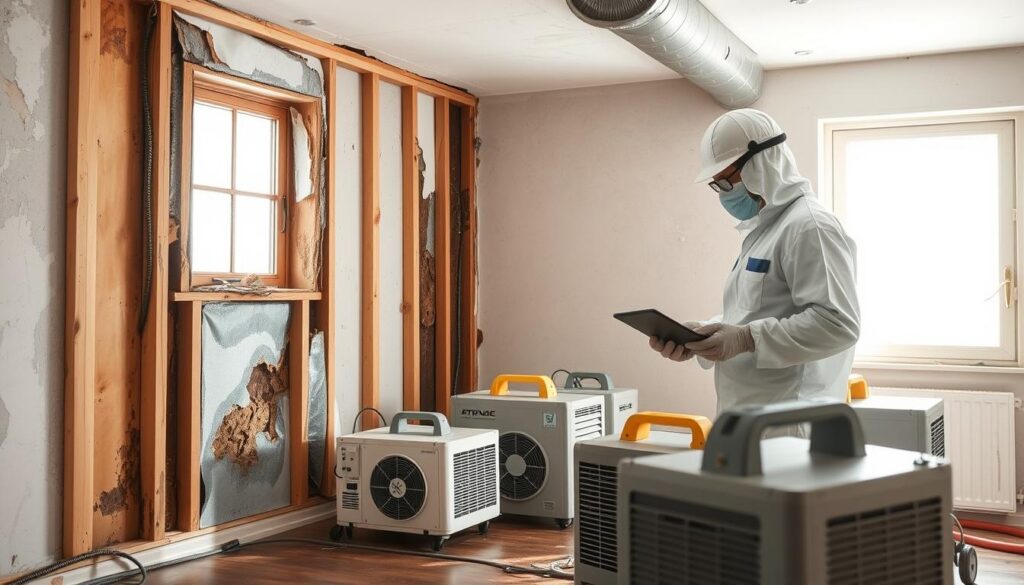
In summary, these home remedies can help, but know their limits and risks. Mixing these with sound-based methods can boost your chances of fixing water damage.
When to Seek Professional Help
Not every water damage issue needs a pro, but some signs say you should get help. When your phone gets wet, it’s key to check it out well. This helps figure out the right thing to do next.
Signs You Need Expert Assistance
If DIY fixes don’t work and your phone still doesn’t work, it’s time for a pro. Look out for these signs that mean you need an expert:
- Your phone won’t turn on, even after charging it a lot.
- There’s visible corrosion on the inside parts.
- There’s big damage to the phone’s circuitry or other important parts.
- The phone’s speakers or other parts don’t work right, even after drying.
Avoiding Further Damage
While waiting for or looking for help, it’s important not to do things that could make damage worse. Here are some tips:
- Avoid turning on your phone: This can cause short circuits and more damage.
- Don’t try to dry your phone using heat: Heat from a hairdryer or other devices can harm your phone’s inside parts.
- Keep it dry and cool: Put your phone in a dry, cool spot to slow down corrosion.
- Use a water-absorbing product: Stuff like silica gel packets can soak up moisture from your phone.
By knowing when to get professional help and avoiding more damage, you can better fix your water-damaged smartphone.
Preventive Measures
Preventing water damage to your phone is more than just being careful. It’s about being ready. Taking the right steps can save you from the trouble and cost of fixing or replacing your device.
Water-Resistant Phone Cases
Using a water-resistant phone case is a great way to protect your phone. These cases act as a shield between your phone and water. This greatly lowers the chance of damage.
- Material and Design: Choose cases made from top-notch, waterproof materials like rubber or special plastics.
- Seal and Closure: Make sure the case has a tight seal around the edges and openings to keep water out.
- Certification: Go for cases with IP68 certification. This means they can handle being underwater.
Best Practices During Exposure
Even with a water-resistant case, it’s key to follow best practices when your phone might get wet.
- Avoid Submersion: Don’t put your phone in water, even if it’s in a water-resistant case.
- Dry Immediately: If your phone gets wet, dry it right away with a soft cloth.
- Turn Off: Turn off your phone to stop short circuits.
By using a water-resistant phone case and following these best practices, you can greatly lower the risk of water damage to your phone.
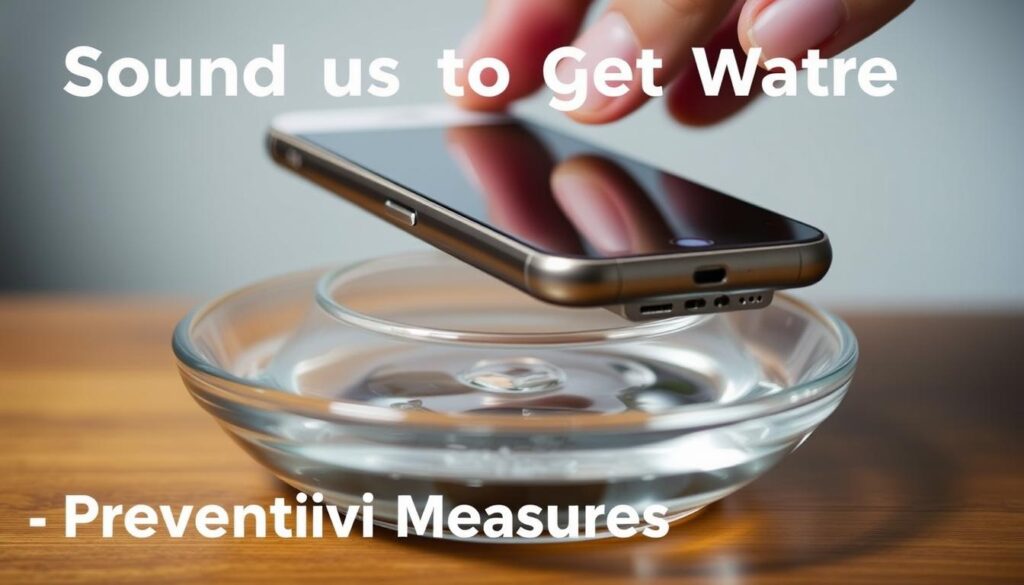
For extra protection, think about using phone water extraction techniques if your device does get wet. Methods like sound frequencies can help remove water from your phone’s inside parts.
Common Myths About Water Removal
Many myths and misconceptions can harm your phone when trying to remove water. It’s key to know the truth to save your device.
Misconceptions About Sound Techniques
Some think any sound can remove water from your phone. But, not all sounds work the same. High-frequency tones are best because they push water out of tight spots better than low sounds.
Another myth is that sound drying is a new idea. But, it’s been around for years. It’s become more popular with apps and videos that help.
Facts vs. Fiction
Let’s look at the truth and myths about removing water with sound.
| Myth | Fact |
|---|---|
| Using any sound frequency can help remove water. | Specific frequencies, especially high-frequency tones, are more effective. |
| Sound techniques alone can completely dry a wet phone. | While sound can help, it’s often used in conjunction with other drying methods for better results. |
| All sound apps are equally effective. | The effectiveness can vary based on the app’s quality and the sound frequency it produces. |
Knowing these myths and facts helps you make better choices to save your phone. While sounds to get water out of phone can be helpful, using it right and with other methods is key.
Real-Life Success Stories
Sound techniques in phone water removal have proven effective in real-life scenarios. Many have successfully dried their phones using these methods.
Instances of Sound Techniques Working
Many people have used sound to dry their phones after water damage. For example, a user on a tech forum saved their phone after it fell in a bathtub. They used a high-frequency tone and it worked perfectly. Similar stories are found online, showing sound waves’ potential in drying phones.
Here’s a table showing some success rates:
| Device Type | Water Exposure | Sound Technique Used | Outcome |
|---|---|---|---|
| Smartphone | Submerged in water | High-frequency tone | Fully functional |
| Smartphone | Exposed to rain | White noise | Fully functional |
| Smartwatch | Submerged in water | Low-frequency vibration | Fully functional |
Testimonials and User Experiences
Users have shared their positive experiences with sound techniques. One user said, “I was skeptical, but after a few minutes, my phone was fine.” These stories highlight the method’s value.
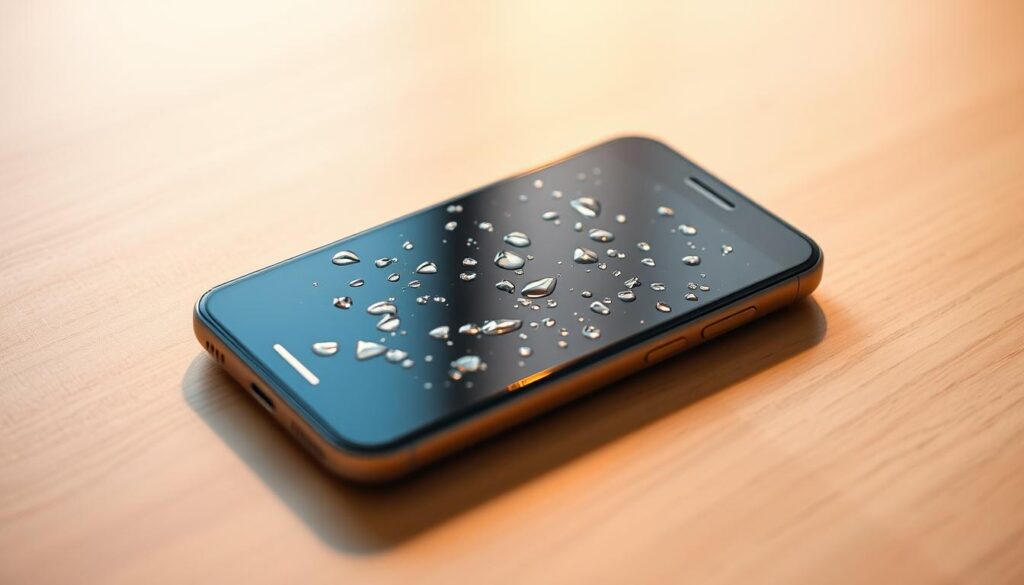
While results may vary, the overall evidence supports sound techniques for phone water removal.
Additional Resources
If you’re still having trouble with water in your phone, don’t worry. There are many more resources to help you fix it. Apps, tools, and expert guides can offer the extra help you need.
Recommended Apps and Tools
There are apps and tools that can help remove water from your phone. Some of the best include sound frequency generators and water detection apps.
- Sound Frequency Generators: Apps like “Sound Frequency Generator” can produce sounds to help get water out of your phone’s speakers.
- Water Detection Apps: Apps such as “Water Damage Detector” can tell if there’s still water in your phone, helping you know what to do next.
| App/Tool | Description | Platform |
|---|---|---|
| Sound Frequency Generator | Generates specific sound frequencies to help remove water | iOS, Android |
| Water Damage Detector | Helps detect water presence inside the phone | iOS, Android |
| Phone Dryer | An app that claims to dry your phone using sound waves | iOS |
Expert Articles and Guides
If you’re looking for more detailed help, there are many expert articles and guides online. These resources provide detailed instructions and the latest methods for fixing water damage.
Some top resources include tech blogs, manufacturer guides, and forums. These places are where users share their experiences and solutions.
Conclusion
Dealing with water damage can be stressful. But, acting fast and using the right methods can help a lot. Using sounds to get water out of your phone is one way to save it.
Key Takeaways for Smartphone Care
To keep your phone safe, be proactive. Getting a waterproof speaker is a smart move. It lets you listen to music without worrying about water damage.
Also, check your phone’s speaker often for water damage signs. Look for crackly or muffled sounds. This helps you fix problems early.
Preventive steps are key to avoiding water damage. Use water-resistant cases and be careful around water. Being aware and acting quickly can make your phone last longer.
FAQ
What are the best sounds to get water out of my phone?
High-frequency tones, low-frequency vibrations, and white noise are good for removing water from phones. You can find these sounds on sound apps or online.
How does water damage affect my smartphone?
Water damage can cause corrosion and short circuits. It can also harm internal parts. This can lead to problems like malfunctioning screens or speakers. It’s important to act fast to minimize damage.
Can I use any sound app to remove water from my phone?
Not all sound apps are the same. Look for apps made for water removal. Read reviews to make sure they work well. Some apps let you customize frequencies for better results.
Are there any DIY techniques for creating sound frequencies to remove water?
Yes, you can make custom sound frequencies with audio editing software or online tools. You can also use your home speakers to play these frequencies. This might help remove water.
How can I prevent water damage to my phone in the future?
Use a water-resistant phone case and be careful in wet places. Avoid getting your phone wet. Clean your phone’s ports and crevices regularly to reduce risk.
What are some common myths about water removal techniques?
One myth is that rice is the best way to dry a wet phone. But sound waves and silica gel can work just as well. It’s important to know the facts about water damage.
When should I seek professional help for water damage?
If your phone won’t turn on or shows signs of corrosion, get professional help. This can prevent more damage.
Can phone water extraction methods damage my phone’s speakers?
Using sound to remove water is usually safe if done right. Just make sure the volume isn’t too high to avoid damaging your speakers.
Are there any recommended apps or tools for water removal and prevention?
Yes, there are apps and tools for water removal, like sound frequency generators and water detection apps. Look for reputable ones to help.
